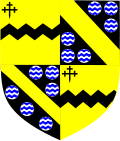Vavasour baronets
There have been five baronetcies created for persons with the surname Vavasour, three in the Baronetage of England and two in the Baronetage of the United Kingdom. As of 2008 four of the creations are extinct while one is extant.
The Vavasour Baronetcy, of Hazlewood in the County of York, was created in the Baronetage of England on 24 October 1628 for Thomas Vavasour. (He was the de jure 19th Baron Vavasour but the title had been dormant for centuries since the death of the 2nd Baron.) The title became extinct on the death of the seventh Baronet in 1826.
The Vavasour Baronetcy, of Killingthorpe in the County of Lincoln, was created in the Baronetage of England on 22 June 1631 for Charles Vavasour. The title became extinct on his death in 1644.
The Vavasour Baronetcy, of Copmanthorpe in the County of York, was created in the Baronetage of England on 17 July 1643 for , brother of Charles abovementioned. The title became extinct on his death in 1659.
The Vavasour Baronetcy, of Spaldington in the County of York, was created in the Baronetage of the United Kingdom on 20 March 1801 for Henry Vavasour. The title became extinct on the death of the third Baronet in 1912.
The Vavasour Baronetcy, of Hazlewood in the County of York, was created in the Baronetage of the United Kingdom on 14 February 1828 for Edward Vavasour. He was the third son of Charles Stourton, 17th Baron Stourton (see Baron Stourton for earlier history of the family), and the maternal cousin of the seventh and last Vavasour Baronet of the 1628 creation. He succeeded to the Vavasour estates and assumed by Royal licence the surname of Vavasour.
Vavasour baronets, of Hazlewood (1628)[]
1st creation
- Sir Thomas Vavasour, 1st Baronet (died before 1636)
- Sir Walter Vavasour, 2nd Baronet (died after 1666)
- Sir Walter Vavasour, 3rd Baronet (c. 1644 – 1713)
- Sir Walter Vavasour, 4th Baronet (c. 1659 – 1740)
- Sir Walter Vavasour, 5th Baronet (died 1766)
- Sir Walter Vavasour, 6th Baronet (1744–1802)
- Sir Thomas Vavasour, 7th Baronet (c. 1745 – 1826)
Vavasour baronets, of Killingthorpe (1631)[]
Vavasour baronets, of Copmanthorpe (1643)[]
Vavasour baronets, of Spaldington (1801)[]
- Sir Henry Vavasour, 1st Baronet (died 1813)
- Sir Henry Maghull Mervin Vavasour, 2nd Baronet (1768–1838)
- Sir Henry Mervin Vavasour, 3rd Baronet (1814–1912)

quarterly Vavasour & Stourton
Vavasour baronets, of Hazlewood (1828)[]
Second creation
- Sir Edward Marmaduke Stourton Vavasour, 1st Baronet (1786–1847)
- Sir Edward Marmaduke Vavasour, 2nd Baronet (1815–1885)
- Sir William Edward Joseph Vavasour, 3rd Baronet (1846–1915)
- Sir Leonard Pius Vavasour, 4th Baronet (1881–1961)
- Sir Geoffrey William Vavasour, 5th Baronet (1914–1997)
- Sir Eric Michel Joseph Marmaduke Vavasour, 6th Baronet (born 1953)
The heir apparent to the baronetcy is Joseph Ian Hugh Andre Vavasour (born 1978), eldest son of the 6th Baronet.
Citations and sources[]
Citations[]
- ^ Burke & Burke 1844, p. 544, right column, line 1: "Vavasour, of Killingthorpe. Created 22th June 1631.—Extinct about 1665."
- ^ Cokayne 1902, p. 78, line 32: "Charles Vavasour, or Vavasor: cr. 22 June 1631 with a spec. clause as to precedency; ex. Feb. 1643/4."
- ^ Burke & Burke 1844, p. 544, right column, line 10: "Vavasor, of Copmanthorpe. Created 17th July 1643.—Extinct 18th February 1659."
- ^ Cokayne 1902, p. 212, line 12: "Vavasour, or Vavasor: cr. 17th July 1643; ex. 18 Feb. 1659 'William Vavasor of Yorkshire, Esq.' i.e. of Copmanthorpe in that county, br [brother] of Sir Charles Vavasour, Bart. ..."
Sources[]
- Burke, John; Burke, Bernard (1844). A Genealogical and Heraldic History of the Extinct and Dormant Baronetcies of England, Ireland and Scotland (2nd ed.). London: John Russell Smith.
- Cokayne, George Edward (1902). Complete Baronetage, 1611 to 1800. Vol. 2 (1st ed.). Exeter: William Pollard & Co. OCLC 866278985. – 1625 to 1649
- 1628 establishments in England
- Baronetcies in the Baronetage of the United Kingdom
- Extinct baronetcies in the Baronetage of England
- Extinct baronetcies in the Baronetage of the United Kingdom
- Vavasour family